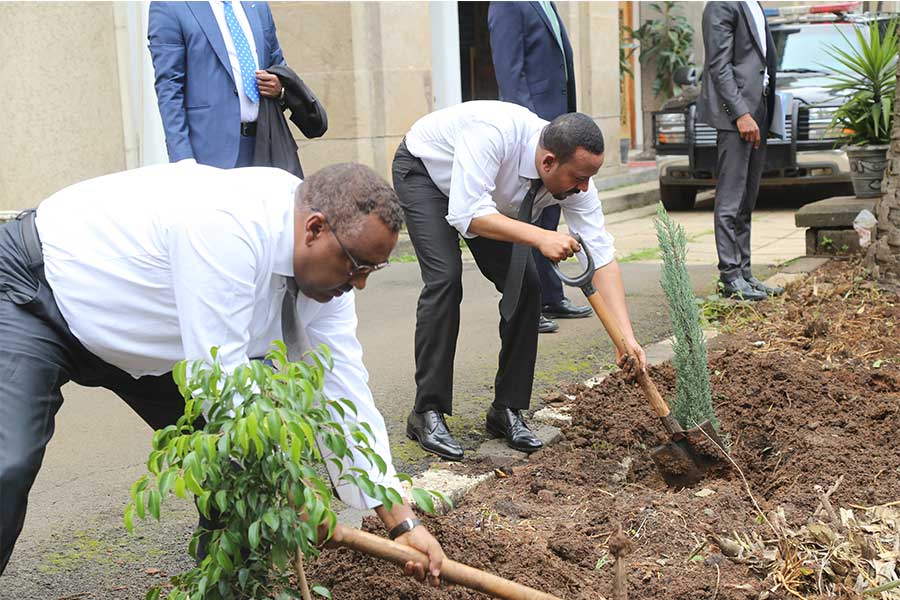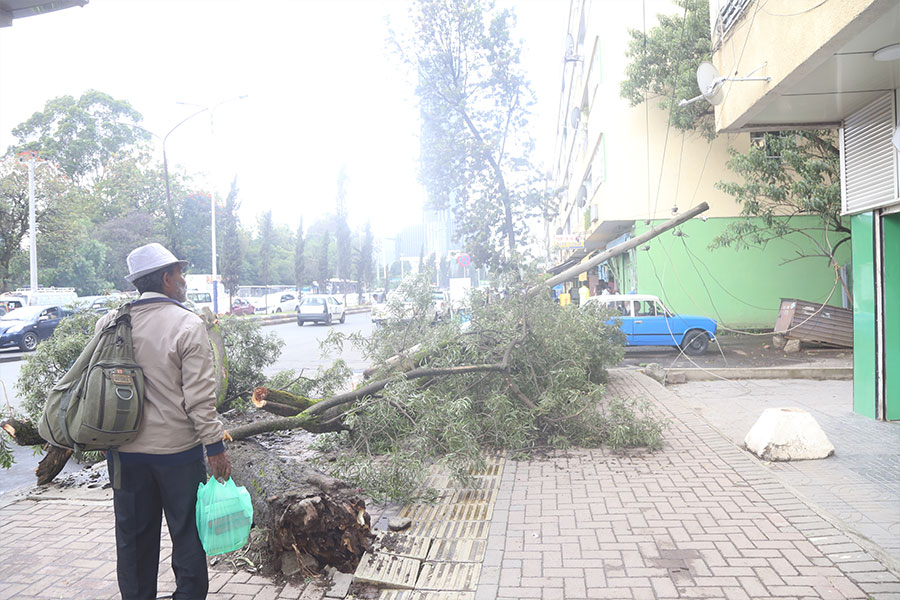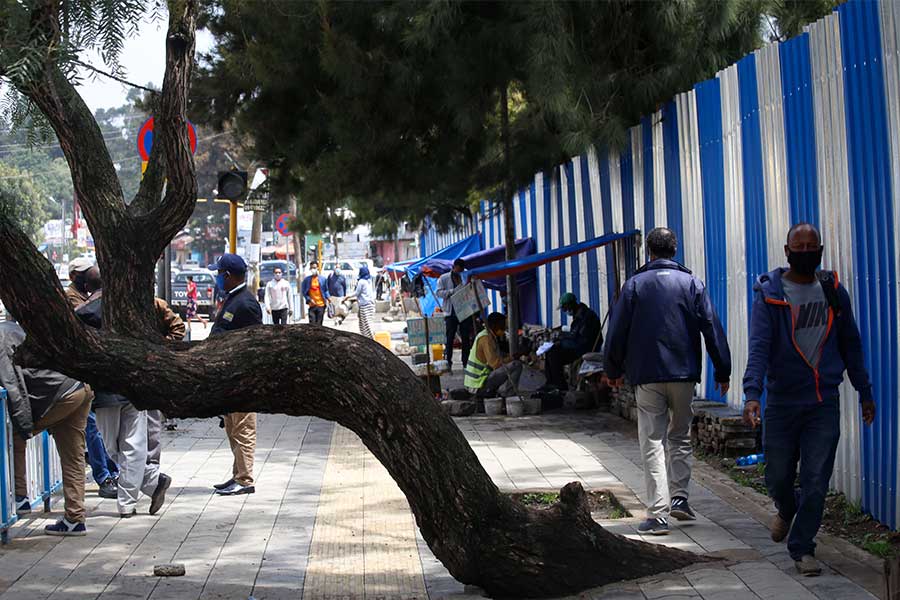
Agenda | Jul 27,2019
Confused with my earlier dotty categorisation of trees, as though they all are the same, except in looks, I was at an impasse to tell what differentiates them. Then I started to vet what comes first to my mind, something intertwined with my formative days.
I stared at a 1960s aerial image of our village, where I am from. There is a glimpse of the house where I was born, impeding a road that was yet to come, with all the eucalyptus trees rising from the rich shady groves. Who knows, at the exact moment that photo was taken, I was bathing in the morning sun, in my mom’s lap, breathing the trees' scented air.
This is not to mention the ambience set by the eucalyptus trees at the main entrance of Hilton Addis, reminiscent of my childhood days. The sun back then was very different.
I cannot think of my childhood without it, nor is it easy to reminisce about Addis Abeba without them. The genus of trees is laced with stories of how they were introduced in Ethiopia during the reign of Emperor Menilek II from Australia. They were considered valuable for sourcing wood, for fuel and constructing mud houses, for the new but growing capital city - Addis Abeba.
It was not hard to see its appeal. Its renown as easily the tallest of all trees – currently, the record for the tallest of them all is an almost 100m Australian tree called Centurian.
A large, fast-growing evergreen, indigenous to Australia, it is the most planted tree species across the world, owing to its fast growth and rising demand for paper and plywood. There remains a widening gap between supply and demand, creating an incentive for planting it instead of agricultural crops.
But the tree is considered bad for the environment in its own right as well. It drains water resources, enhances soil erosion, depletes the soil of its nutrients, and has the unusual inability to provide habitat or food for native wildlife. Neither is it appreciated for changing the soil’s acidity levels, reducing the diversity and productivity of understory species. This is why the tree is considered invasive and shines a light on why planners in Addis Abeba have come to regret the decisions of their predecessors.
But the eucalyptus never gave in; it threw its hat into the ring with a strong statement. It has too many advantages to be placed aside. Extenuating remarks in its manifold environmental and socioeconomic benefits swirl. It grows fast, requires minimal care, thrives in poor environmental and ecological areas, is resistant to environmental stress and diseases, and produces seeds easy to collect and sow.
It is also a safeguard against many, including farmers that are between a rock and a hard place on land unsuited to sustainable agriculture. Their answer could be eucalyptus trees, which can survive in some of the worst soil compositions, endure terrible weather conditions and still make themselves useful to meet the heavy demand for fuel, construction and furniture.
They also look great, a plus for a city that already has them. Take Entoto Mountain, which is made lush green by this genus of tree. Its aesthetic quality is revealed evermore by the landmark stride being made by the government to preserve public spaces as tourist attractions. The revamping of the area into Entoto Park is a showcase of the potential of the trees to espouse elegance.
It should thus be obvious that eucalyptus trees should not be discarded out of hand. As concluded from detailed studies, to avoid or minimise the pain from sitting on the horns of the eucalyptus dilemma, environmentalists, researchers and policymakers must hold hands to come to an understanding. They should, in fact, support growers, but with the caveat that the appropriate place to plant it - such as degraded land, steep slopes and waterlogging - are carefully selected.
As it is observed from the interactions between local communities and state forests, through the exploration of how it is affecting them and the underlying causes, the eucalyptus comes in handy in diffusing tensions between forest managers and surrounding communities.
As a result, illegal timber trading, which will always exist as long as the demand exists and will not be addressed through policing alone, can benefit from such interventions. It is only when the two parties come together, and the local communities are empowered, that the process of development and conservation of state forests can be realised.
As the pressure from population growth and poverty worsen, there will be no substitute for community participation in forest management.
Estimates on the amount of land that is currently covered by eucalyptus trees in Ethiopia stands at 500,000 hectares. This may seem like a huge number, but it is less than 0.5pc of the country’s entire land coverage. This is land that cannot just be rid of plants without consequences, thus the need to preserve them. There are also pieces of land suffering from soil erosion, and are inhabitable to almost any other type of tree. This is where the eucalyptus trees can help and contribute positively to the nation’s demand for timber in construction and bio-fuel.
PUBLISHED ON
Sep 27,2020 [ VOL
21 , NO
1065]


Agenda | Jul 27,2019

Radar | Nov 12,2022

Editorial | Feb 12,2022

In-Picture | Aug 17,2025

Viewpoints | Nov 30,2019

Radar | Jul 13,2020

Radar | May 25,2024

Fortune News | Jan 11,2020

Radar | Apr 29,2023

Radar | Oct 03,2020

Dec 22 , 2024 . By TIZITA SHEWAFERAW
Charged with transforming colossal state-owned enterprises into modern and competitiv...

Aug 18 , 2024 . By AKSAH ITALO
Although predictable Yonas Zerihun's job in the ride-hailing service is not immune to...

Jul 28 , 2024 . By TIZITA SHEWAFERAW
Unhabitual, perhaps too many, Samuel Gebreyohannes, 38, used to occasionally enjoy a couple of beers at breakfast. However, he recently swit...

Jul 13 , 2024 . By AKSAH ITALO
Investors who rely on tractors, trucks, and field vehicles for commuting, transporting commodities, and f...

Sep 13 , 2025
At its launch in Nairobi two years ago, the Africa Climate Summit was billed as the f...

Sep 6 , 2025
The dawn of a new year is more than a simple turning of the calendar. It is a moment...

Aug 30 , 2025
For Germans, Otto von Bismarck is first remembered as the architect of a unified nati...

Aug 23 , 2025
Banks have a new obsession. After decades chasing deposits and, more recently, digita...